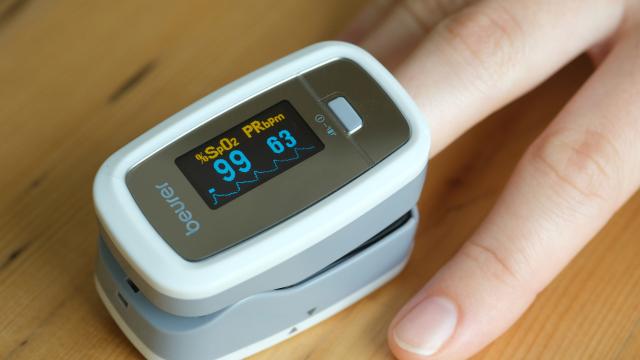Doctors have reported a strange phenomenon as they treat coronavirus infections: Patients who are able to breathe normally and feel fine but have blood oxygen levels that are dangerously low. What causes this “happy hypoxemia,” as it’s known, and could it affect how doctors manage covid-19 patients?
Hypoxemia is defined as a lower-than-normal level of oxygen in the blood, which is usually measured through our arteries. Hypoxemia can be caused by lots of things, like exercise, asthma, and being at a high altitude where there is less oxygen in the air. While not necessarily life-threatening, hypoxemia can lead to hypoxia, a lack of oxygen to our body’s organs and tissues. If hypoxia lasts long enough, and without medical intervention, those starved body parts can die—and often enough, so do we.
Though we’re discovering all sorts of ways that covid-19 can affect the body beyond the respiratory system, it still primarily kills people through the lungs. The coronavirus behind covid-19 can cause a serious infection and massive inflammation in the lungs, called pneumonia. This pneumonia can destroy the lungs to the point where they can’t get oxygen to the rest of the body, causing organ failure and death.
For many covid-19 patients, hypoxemia can be the first major warning of a severe infection. These people typically feel short of breath and/or easily exhausted. But doctors have reported that many patients’ breathing often appears outwardly normal by the time they visit a hospital with a fever or other symptoms, without the classic physical signs of oxygen deprivation.
“A vast majority of covid pneumonia patients I met had remarkably low oxygen saturations at triage—seemingly incompatible with life—but they were using their mobile phones as we put them on monitors,” Richard Levitan, an emergency doctor who treated patients in New York City, wrote in the New York Times last month.
At this point, it’s not clear why happy hypoxemia, also called silent hypoxemia, happens in these patients. Some scientists have theorised that the coronavirus can somehow affect our body’s hemoglobin, the protein responsible for ferrying oxygen through our red blood cells. That would be yet another unexpected trick from a virus that hasn’t proven short of them. But other doctors believe there’s a more mundane explanation.
According to Albert Rizzo, chief medical officer of the American Lung Association, the lungs of covid-19 patients with silent hypoxemia might be damaged in a specific way. The lungs largely still work, but parts have collapsed air sacs caused by fluid buildup and inflammation. These downed air sacs create a shunt, where blood flowing through the affected lung tissue doesn’t pick up oxygen. At the same time, the lungs themselves haven’t stiffened to the point that blood flow has stopped and stored carbon dioxide (CO2) isn’t being exhaled out.
Low oxygen levels can make us feel short of breath, but it’s the buildup of CO2 that’s thought to be the primary trigger for that sensation. So happy hypoxemics might not receive the body’s warning signal that something is wrong, at least initially.
“If the lung is not stiff, and all that’s happening is that the blood flow and ventilation flow are mismatched, then oxygen levels may drop and the patient may not sense any change in the work of breathing, and therefore they don’t look short of breath,” Rizzo told Gizmodo.
The phenomenon of silent hypoxemia isn’t exactly new. Prior to covid-19, doctors would report similar symptoms for the odd case of flu or other respiratory infection. In those cases, the cause was usually the sort of shunting mismatch that Rizzo describes. But we’re still not sure if that’s the whole story with covid-19 or whether this happens more with covid-19 than it does with other lung infections.
Regardless of how silent hypoxemia is happening in coronavirus patients, it’s presented another complexity for doctors in how to treat serious cases. Initially, many felt it necessary to quickly place patients on ventilators once their blood oxygen level reached a certain low point. But silent hypoxemia cases in the hospital might benefit from more conservative treatment at first, such as keeping people propped up in a face-down position, where oxygen can better reach the blood, or non-invasive methods of providing oxygen like nasal cannulas.
Some doctors, including Levitan, have also argued that if the silent version of this condition is common among covid-19 patients who could become very sick, then it makes sense to widely screen people at home for low blood oxygen, using a tool known as a pulse oximeter. Rizzo doesn’t endorse that idea, not without more data first to support its rationale (such as whether low blood oxygen actually appears before more visible symptoms of covid-19). But for patients with illness that isn’t serious enough to merit hospitalisation, he added, take-home pulse oximeters have become an easy way to closely monitor their health, just in case they worsen.
Unfortunately, people with silent hypoxemia can be still in danger, according to Rizzo.
“I think the main message here is that if somebody has an oxygen level lower than what appears to be the case, even if they look fine, something’s still going on. And this somebody either needs to be admitted or [given] further monitoring where they’re being sent with a pulse oximeter, as long as they seem competent and they have a caregiver at home” he said. “It’s definitely something that could certainly progress more rapidly.”
